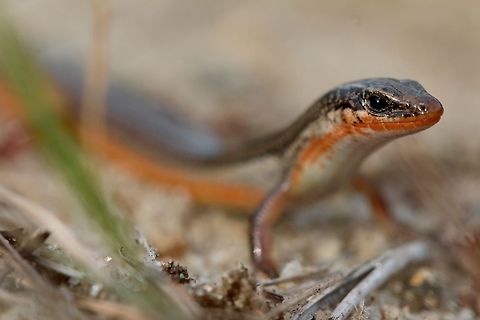
Appearance
The bluetail mole skink is a small, shiny, cylindrical lizard of a brownish color. Juveniles usually have a blue tail which makes up slightly more than half of the animal's total length. Regenerated tails and the tails of older individuals are typically pinkish. The legs are somewhat reduced in size and are used only during surface locomotion, not when the animal "swims" through the sand . During the breeding season, males develop a colorful orange pattern on their sides.The bluetail mole skink grows to 9 to 15 cm .
Status
The first three subspecies listed above are protected, and the bluetail mole skink is classified as a threatened species since 1987. The major threats to all three subspecies are habitat destruction due to residential, commercial, and agricultural development and overcollection by herpetological enthusiasts. The remaining two subspecies are rather common. The northern mole skink also occurs in southern Alabama and Georgia.The bluetail mole skink is a Threatened Species.Behavior
It shares habitat with the sand skink, which is also endangered, but does not compete with it: whereas the sand skink feeds underground, the bluetail mole skink hunts on the surface.Habitat
Mole skinks are found in sandhills and scrub. They often like to be buried underground and live there.It shares habitat with the sand skink, which is also endangered, but does not compete with it: whereas the sand skink feeds underground, the bluetail mole skink hunts on the surface.Reproduction
Mole skinks reach sexual maturity after one year. They mate in winter; the female lays three to seven eggs in spring in a shallow nest cavity less than 30 cm below the surface. The eggs incubate for 31 to 51 days, during which time the female tends the nest.Food
Like other mole skinks, it feeds primarily on cockroaches, spiders, and crickets.References:
Some text fragments are auto parsed from Wikipedia.